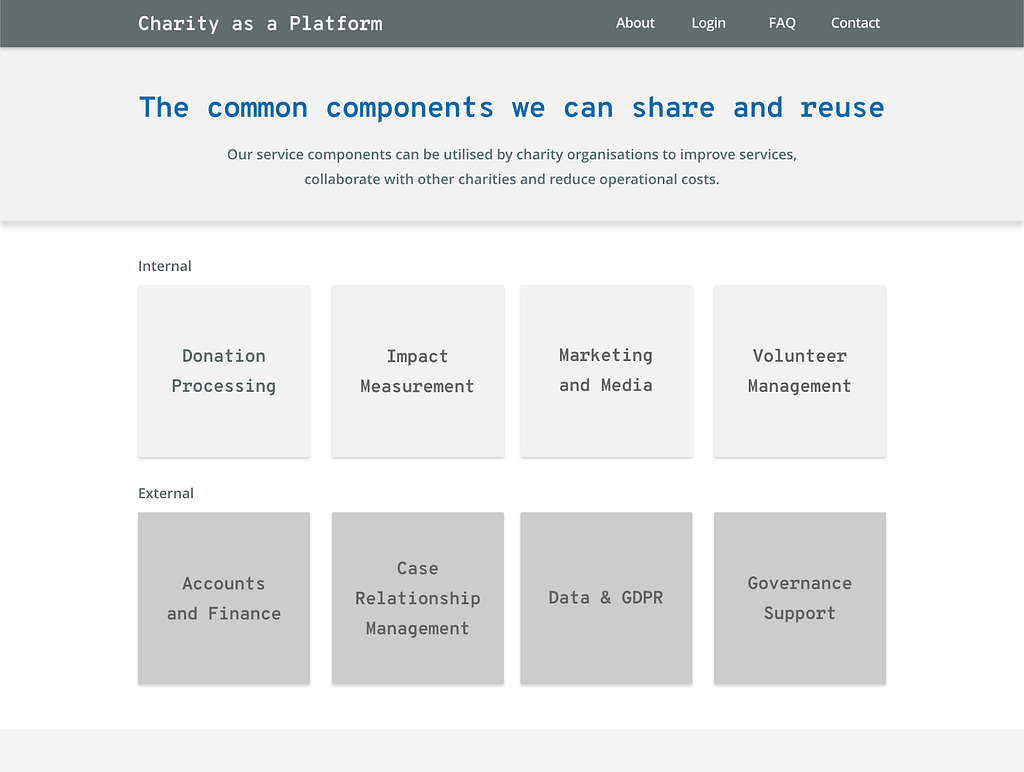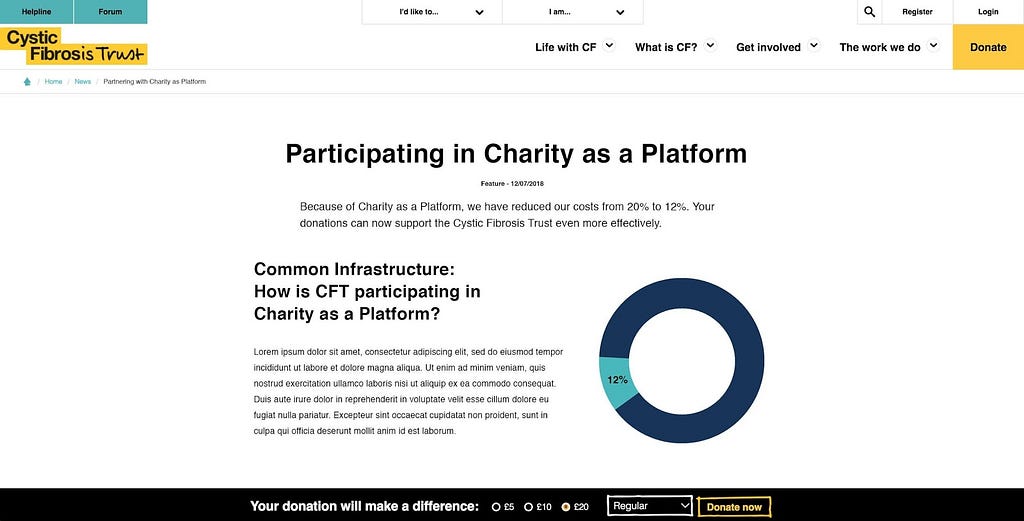‘Charity as a Platform’ — a prototype
‘Charity as a Platform’ — a prototype

‘Charity as a Platform’ is the second of two concepts we were involved in prototyping over the summer with Snook, the design agency helping organisations produce great services by putting people first, on behalf of the Wellcome Trust’s Public Engagement team, to explore some ways in which they could deliver on their strategic aims.
In the first post by Sarah Drummond, co-founder and Managing Director of Snook, introduces the ‘Citizen Research Centre*’ — a platform to help health research be directed by people, for people.
‘Charity as a Platform’ is a concept to try and make it easier for charities to reduce their operational costs and help build a common infrastructure for the social sector to help strengthen it and build opportunities for collaboration, sector-wide advocacy and enable far greater collective intelligence.
The challenge for charities?
The social sector in general, and specifically in relation to this work, health charities, are needing to constantly rethink how they fundraise, how they respond to the changing context they are working within, and for the smaller charities in particular, simply how they survive.
Some specific sector level needs that came out of our initial interviews with a range of charities included:
As a sector, we need the credibility of health research to be distributed more fairly so that different scales of organisations can survive.
As a sector, we need to encourage collaboration across different scales of health research charities so that we can better shape the effectiveness of the sector as a whole.
And the additional challenge of the increasing perception from the general public that charities don’t use money wisely, leading to a general decline in trust towards charities.
But inevitably a charities’ operational activities, which includes aspects of governance, risk management and functional costs like donation processing and impact reporting, will come at a cost.
And the public’s diminishing trust in charities has been linked to perceptions about how effective they believe charities are being with their operating model, and as a result the allocation of their finances.
“One of the real challenges I think we have in the charity sector is how do we capture and build an evidence base about the outcomes and the impact that we’re having against the resources and decide where to spend that marginal pound”
Mike Adamson, Chief Executive of British Red Cross, commenting in his acceptance of a PwC Building Public Trust Award
Could ‘Charity as a Platform’ change this?
The idea of ‘Charity as a Platform’ is to create a common infrastructure for the social sector, based on the same principles as Government as a Platform — a platform of common tools, components and guidance.This video helpfully explains the concept.

The platform is made up of different components (small parts loosely joined like lego blocks). The components are the activities and services charities commonly need to undertake and provide. These shared technologies support charities to deliver these activities and services more efficiently and effectively and therefore reduce overall costs. Since doing this work Richard Pope has set up a new research project called Platform Land, which is something that the social sector should read and follow with interest.

Ultimately it’s about helping to strengthen the sector through increasing collaboration (through use of common infrastructure and shared data) and bringing more consistency through shared practice.
It’s also about ensuring charities don’t duplicate effort on technology builds and procurement, encouraging more reuse and repurposing, and working more from the premise of “what can we do together that we can’t do alone?”
It’s about strengthening an ecosystem mindset to achieve greater influence and impact.
Through user research and surveys we were able to identify some common needs from across health charities. These included payment systems, volunteer management, triage, donation processing, case relationship management and tools and services for impact measurement.
Investment in common platforms for the charitable sector could save resource, enabling charities to focus their limited funds on addressing the social problems they wish to address and serving their users more effectively. It could also help them evidence to the public how they work operationally, and as a result bring greater trust through transparency.

Where do we go from here?
We took the prototype (which included some screens and click-through journey’s) of how this could work and showed it to a group of charities and wider stakeholders at a workshop to hear their initial responses. Some considerations that arose from the workshop were:
- How and who will maintain and improve the components?
- Which components should be open source and which should have license fees? (if the license fees would enable continuous improvement — something which doesn’t happen anywhere near enough in the social sector)
- What’s the best place to start with something so ambitious and counter-cultural to the sector? Can we prototype the build with a small number of charities first in order to gauge its feasibility and the added value?
“We tested joint procurement and it’s really complicated and hard!”
What’s clear is that there‘s still some work to do around this but it’s important to remember that this sort of approach is not only about reducing costs and being more efficient, as one of the workshop participants articulated brilliantly:
“I think more than just efficiencies will come from this kind of common infrastructure — there will be opportunities too that we don’t know yet”
The Public Engagement team at the Wellcome Trust are currently working out the next steps to take with this work, and would be interested to hear from other foundations and funders who might want to collaborate, or organisations that feel they’ve got work already underway that’s addressing this.
This project was led by senior researcher Lucy Stewart from Snook and Cassie Robinson Strategic Design Director of Doteveryone, now Big Lottery. The project team included Doteveryone’s designers, James Barclay and Josh Kwan.
*Since publishing the idea of the Citizen Research Centre, the boundaries around the term ‘citizen’ have since been highlighted to us. Science works best when it’s global and representative of the diversity of everyone’s health needs and therefore such a platform shouldn’t be something that’s country specific but rather challenge national boundaries and enable the input of global citizens.
‘Charity as a Platform’ — a prototype was originally published in Doteveryone on Medium, where people are continuing the conversation by highlighting and responding to this story.